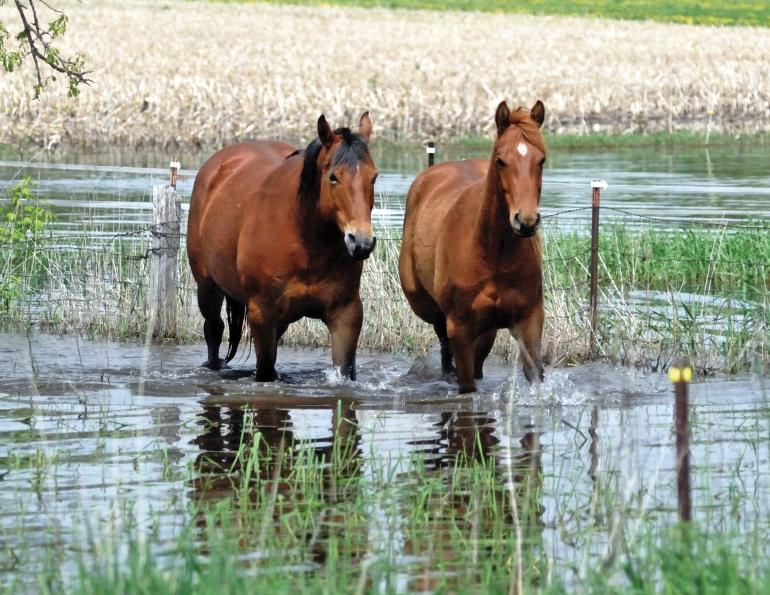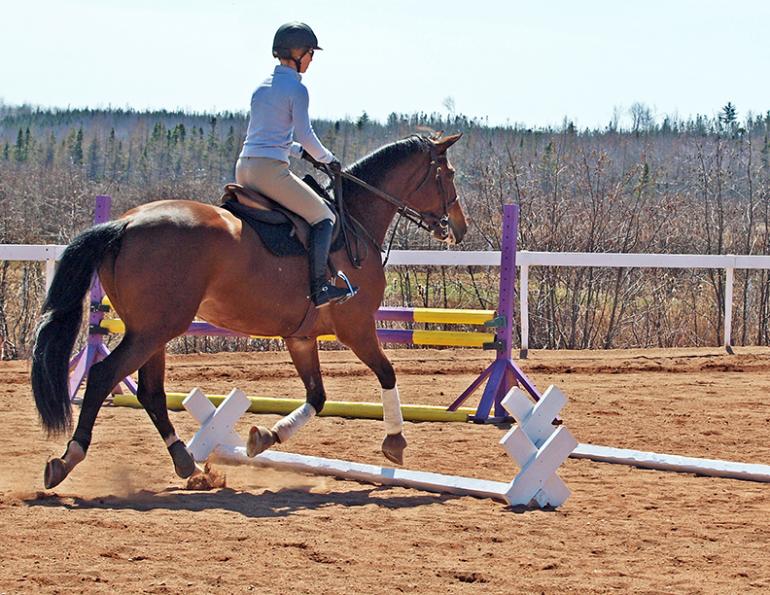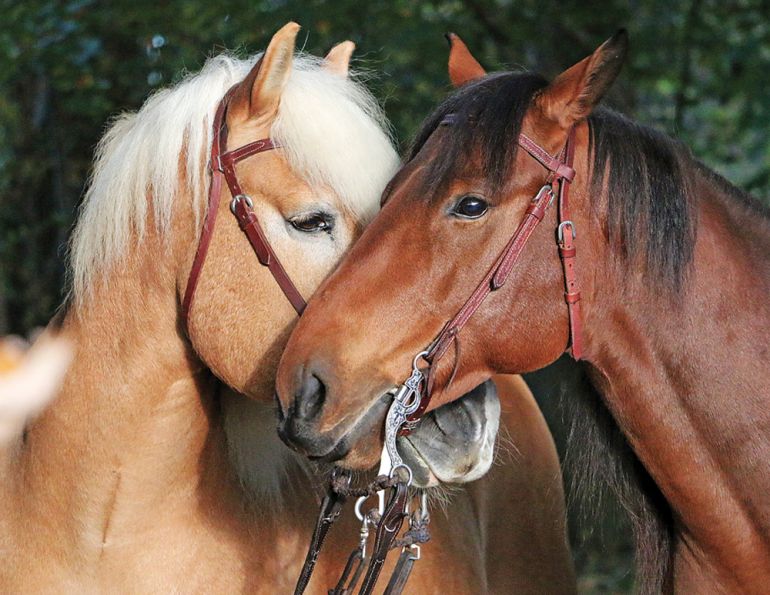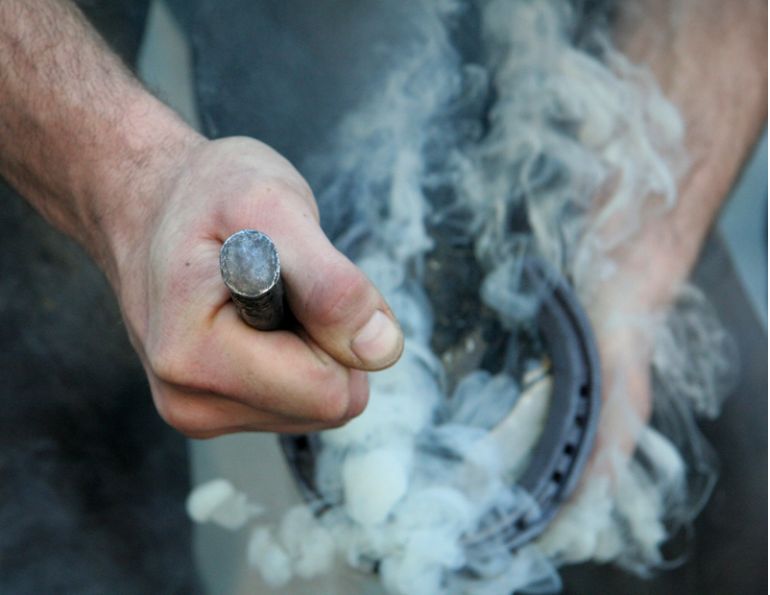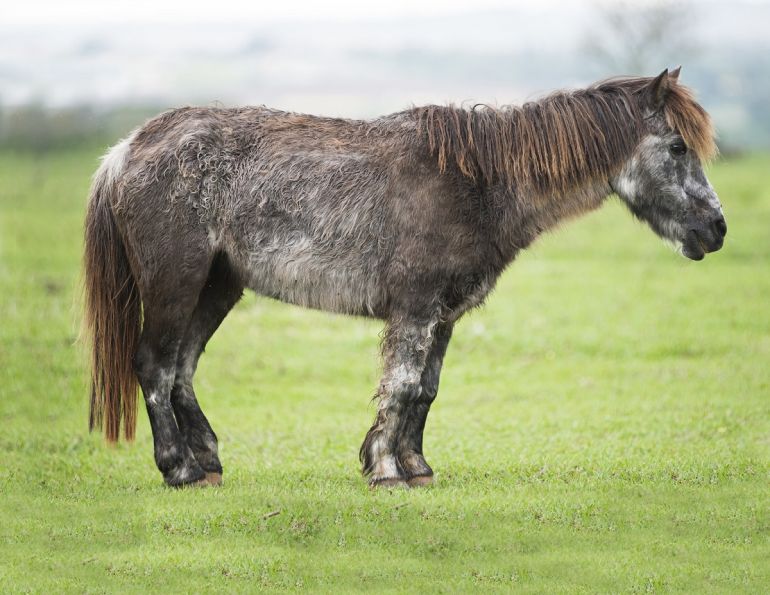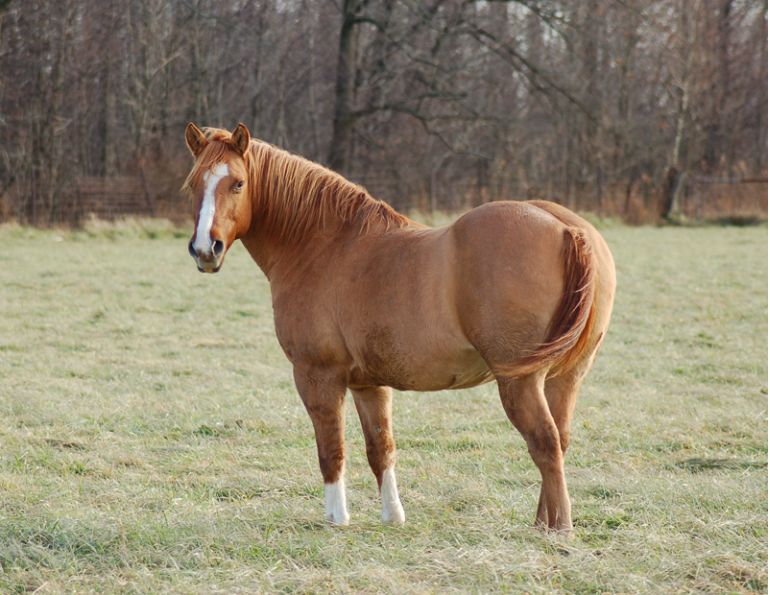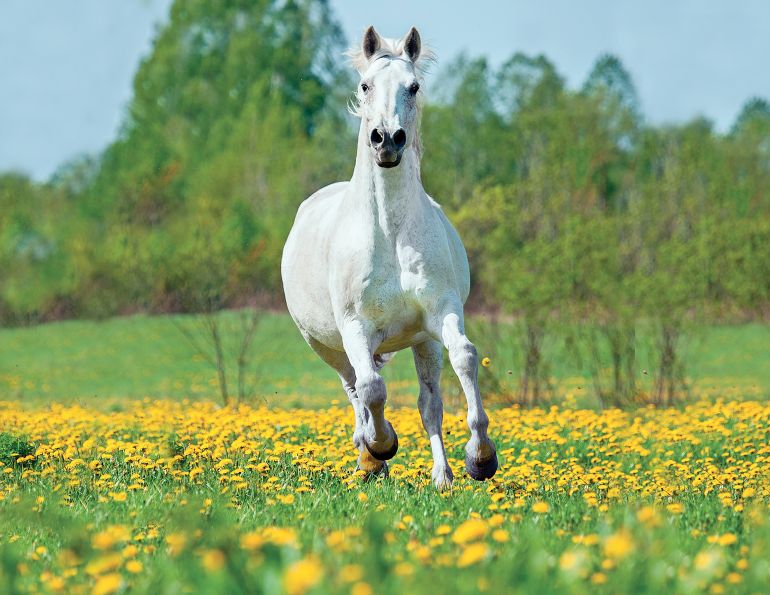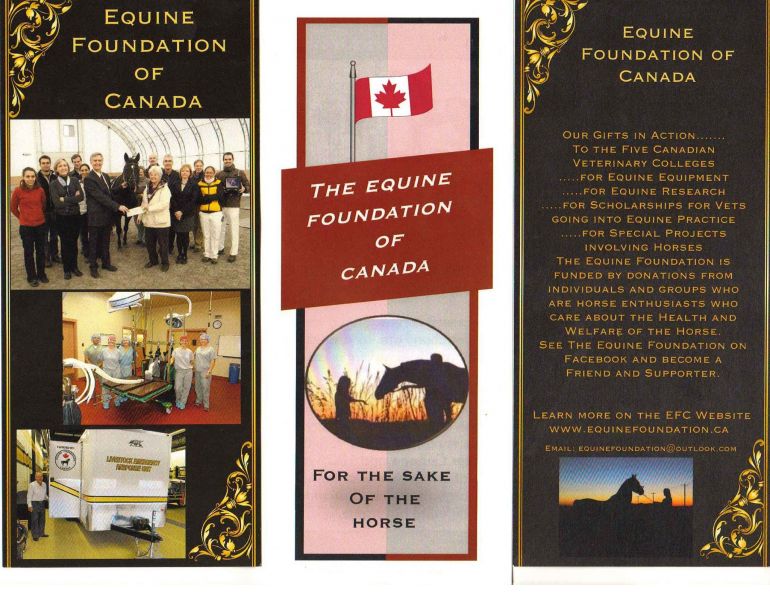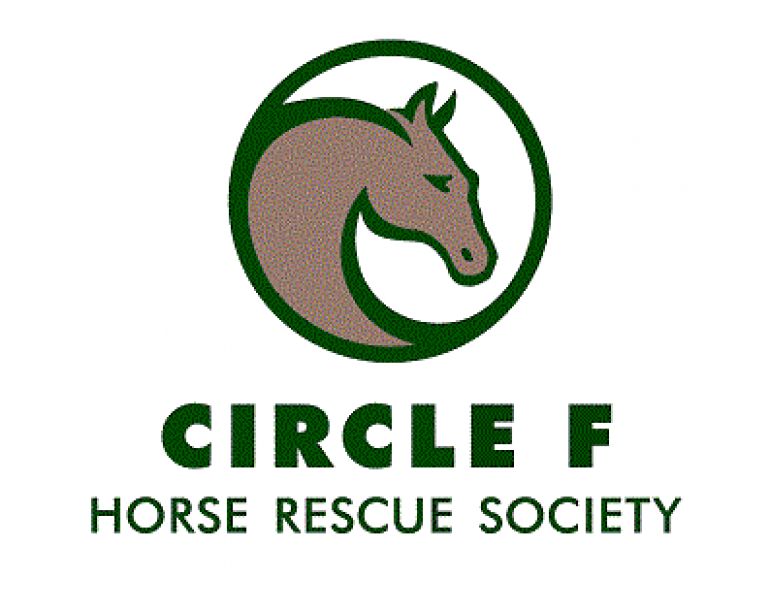Here’s What You Can Do
By Tania Millen, BSc, MJ
Climate change is substantially impacting Canadian horses, horse properties, and their owners. Almost 90 percent of Canadians in recent surveys say they’ve already seen climate change effects in their communities. Horses are increasingly affected by respiratory diseases from wildfire smoke and dust; skin disease and damaged hooves from variable weather; and unforeseen parasites and diseases. Horse owners are struggling to purchase hay, treat unexpected health issues, and adapt to weather-related riding limitations. Meanwhile, property owners are repairing damage from sudden storms, drought, excess water, and wind. So, it’s worth understanding how climate change will affect horses and properties into the future, and what you can do to prepare for these changes.
“Climate” describes the prevailing weather conditions we’ve observed in Canada since the 1870s. Every province, region, and local area is experiencing climate change differently; however, one thing is certain — the weather we’re now experiencing is different from the weather we’ve historically relied upon, and it’s continuing to change. According to Natural Resource Canada’s 2021 National Issues Report, Canada is warming at double the global rate. The report states, “We’re experiencing more extreme heat, less extreme cold, longer growing seasons, shorter snow and ice cover seasons, earlier spring peak stream flow, thinning glaciers, and rising sea levels. Extreme events, such as floods and wildfires, are increasing.” Fortunately, adaptation is possible, which means that horse and property owners can proactively alter their properties and management practices to maximize horse health and reduce property damage.

Nearly 90 percent of Canadians say they have already seen the effects of climate change in their communities. Photo: Shutterstock/Alan Heartfield
Climate Change Effects
Elaine Wheaton is a climate scientist, Associate Professor at the University of Saskatchewan, and Senior Research Scientist at the Global Institute for Water Security. She lives in Saskatchewan and has managed horses, cattle, and crops for many years. Wheaton says that as the climate continues to change, the weather will become more variable and modeling shows, “A storm track that’s wobbling all over the place.” This indicates multiple weeks of stable weather will be less likely, while disaster events will occur one after another. For example, a drought may be interspersed with heavy rain, cold wind, flooding, and violent storms that start wildfires, all of which compound impacts. Wheaton emphasizes, “These [disaster-type events] will be more frequent; they’re becoming more frequent already.”
Not only will the weather be variable, but overall Canada will have hotter, wetter, and drier weather which Wheaton says will contribute to “more flooding, longer droughts, more wind erosion of soils, and increased invasive species.” Already, changing weather is damaging grazing areas, flooding and drying out pastures and pens, producing too much or not enough rain, and eroding land. Weather changes make forage production difficult, resulting in hay and grain shortages and lower quality or changeable nutrient-value feeds. Drought-stressed hayfields have higher sugar content but produce lower volumes of hay, while water-logged fields produce high volumes of hay with lower protein content. When hay supplies are scarce, horse owners pay high prices; when hay nutrients are lacking, costly supplementation is required. In 2021, there was a hay shortage from British Columbia to Western Ontario so horse owners couldn’t just purchase hay from another area — the drought was so widespread that sufficient volumes of hay simply weren’t available.
Related: BC's Flooding and Heat Dome Among Most Devastating Climate Events of 2021
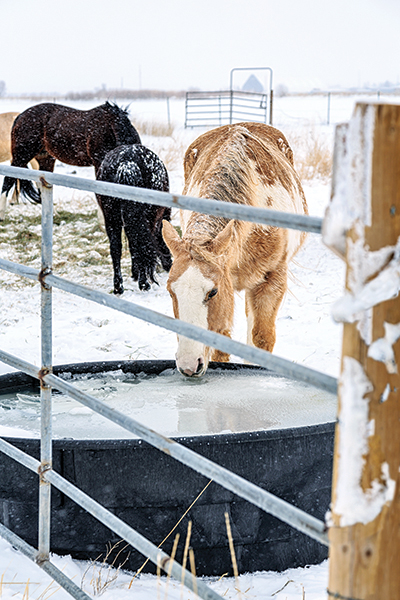
Weather extremes increase the potential for colic. When water becomes frozen and inaccessible, or horses don’t drink enough extremely cold water, impaction colic can result. Excessively hot weather can cause potentially harmful electrolyte losses, which affect the motility of the digestive tract and increase colic risk. Photo: iStock/Willowpix
But changing climate also affects horse health, inducing dehydration, overheating, hypothermia, and weight loss, as well as respiratory, skin, hoof, and eye infections. Wet weather promotes skin diseases such as scratches and rain rot. Dry, windy, or smoky weather enhances dust, which induces respiratory disease and coughs and limits riding time. Fast-changing weather and storms can increase the risk of colic, while seasonal weather changes can affect fertility in broodmares and stallions and reduce breeding success. Drought causes horses’ hooves to dry out and chip, while excess water and mud promote thrush and hoof disease. As the climate changes, bugs, parasites, and diseases move to new areas. Diseases spread faster with broader outbreaks and quicker transmission between horses. Warmer, drier, and wetter weather support different types of biting bugs, which act as disease vectors. Mice, rats, and other rodents expand into new locations. Some of this is already occurring. Wheaton says that diseases carried by insects are being transported into new areas. Ticks are present farther north, are spreading between provinces, and are viable earlier and later in the year. Mosquitos are expanding into new areas, too. She also says horse allergies that haven’t been seen before are increasing, and summer heat stress is a real concern.

This dead horse lodged in a tree is a chilling example of the dangers of flooding. The National Weather Service in Louisville, Kentucky reported that Louisville received 15 inches of rain in 12 cays during the middle of January in 1937. The resulting flood crested 30 feet higher than flood stage, causing 70 percent of the city to be under water, and resulting in $3.3 billion damage in today’s dollars. This horse was swept up in the flood and stuck in a tree where it died. The horse’s head is about 24 feet from the ground. Photo courtesy of National Weather Service, USA.gov
Related: Wildfire! Flood! Earthquake! Horse-Specific Emergency Planning
Proactive Property Solutions
Wheaton advises horse and property owners to be proactive about climate change by preparing for weather possibilities, not just addressing situations as they arise. Properties can be redesigned to deal with irregular weather events, fluctuating temperatures, and extreme storms, while horses can be managed differently. Property owners expecting hotter-than-normal weather should consider access to shade and cooling breezes for their horses; ventilated and insulated barns; low dust driveways, arenas, and pens; and continuous access to freshwater. Horse properties located in areas that are becoming wetter or snowier will need to address excess runoff; icy footing; freezing waterlines and horse waterers; space for stockpiling snow; effective drainage in pens, pastures, and arenas; and ensure that storm-proof shelters are available. Some regions will experience both drier and wetter weather, so property owners may need to plan for both.
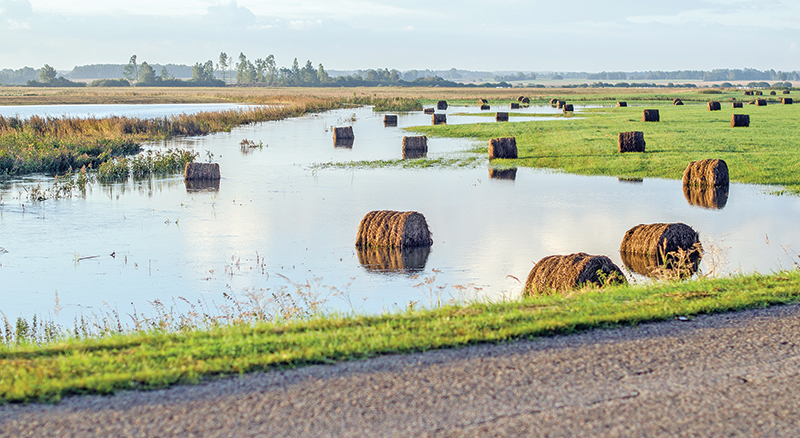
Weather changes make hay production difficult, reducing the supply of quality forage and driving prices up. If possible, horse owners should pre-order hay supplies and use slow feeding hay nets to cut down on waste. Photo: Shutterstock/Bargais
Ensuring enough hay for horses is paramount and developing a long-term relationship with a reliable hay supplier helps both buyers and sellers. Stockpiling hay for multiple years ensures there’s hay in the barn when there’s low supply. Good quality hay, properly stored, will be suitable for consumption for two to three years, but will lose much of its vitamin content within the first few months. Pre-ordering hay early in the year and paying a deposit or the full price of a year’s hay supply before cutting and delivery is prudent. Hay analysis can be used to determine whether supplementation is needed, and annual hay costs can be reduced by using slow-feed hay nets and maximizing grazing.
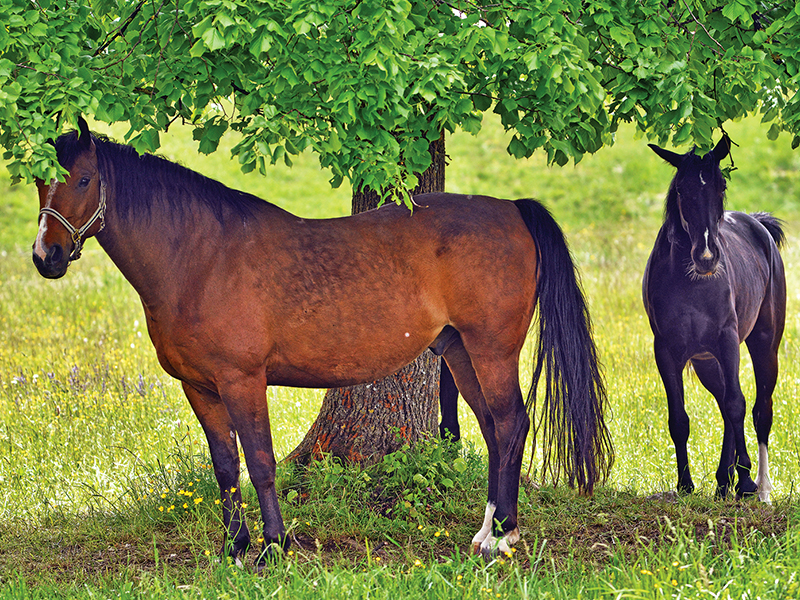
Plant trees in horse pastures to provide shade and shelter to horses in hot weather. Trees also help to maintain soil moisture in dry conditions and absorb excess rainfall in wet weather. Photo: Shutterstock/Miro V
Depending on the weather, grazing pastures may require fewer horses, faster rotations, or different grass species to prevent overgrazing or mud. Using a sacrifice area or dry lot rather than leaving horses on pasture 24/7 helps prevent pasture damage. Different weather may support more weeds or new weed species, so managing pasture weeds by mowing, hand-pulling, or chemicals may be necessary. Planting trees around horse properties and in pastures provides shade, shelter, and cooler temperatures for horses and humans. Trees help maintain soil moisture in drought and absorb excess rainfall from storms.
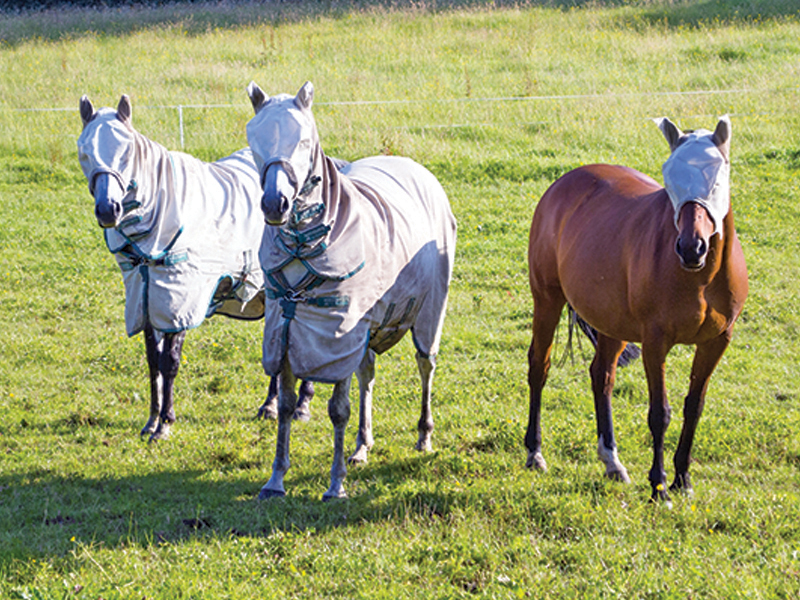
Protect horses from biting insects to reduce parasites and the spread of disease. Ask your veterinarian about vaccinations for diseases that may be spreading into your area. Photo: Shutterstock/Rob Kemp
As internal equine parasites (worms) proliferate due to drug resistance and new weather regimes, additional manure management may be required. Picking up manure daily, stockpiling it on a concrete pad with a covered roof, and regularly removing the pile from the property is integral to reducing internal parasites and biting bugs. Seeding manure piles with predator flies that eat parasite larvae effectively interrupts the parasite-fly cycle.
Improved Horse Management
In these uncertain times, good horse husbandry practices can prevent unnecessary horse health issues. Unhealthy horses can be costly and time-consuming. Obese horses are more likely to founder, suffer from respiratory diseases, require veterinary intervention, and need grazing muzzles, while thin horses require additional blanketing, feed, and supplementation — all of which are expensive. Keeping your horse at optimal body condition (a Henneke equine body condition score of four to six)* costs less in feed, supplements, and veterinary care, plus encourages athleticism and overall horse health. Having your horse’s teeth checked annually ensures proper chewing and digestion of hay, which decreases hay waste, weight loss, the need for expensive supplements, and the potential for colic.
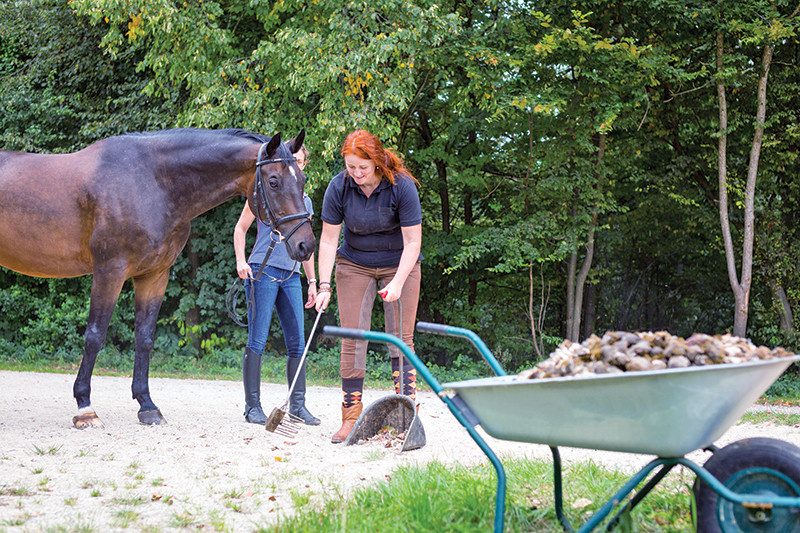
To reduce biting bugs and parasites that can multiply in weather extremes and spread disease to new areas, manure should be picked up daily, stored under cover on a concrete pad, and regularly removed from the property. Seeding manure piles with predator flies that eat parasite larvae interrupts the parasite-fly cycle. Photo: Shutterstock/Nullplus
Protecting horses from biting insects is also important as disease-carrying flies migrate to new areas. Fly sheets, fly boots, face masks, plus chemical creams and sprays can all help reduce bug bites, break the internal parasite cycle, and reduce the spread of disease. Biting flies and parasites have interlocked cycles, and a veterinarian can help determine the best internal parasite deworming schedule and products for your horse and region. A veterinarian can also provide advice about suitable vaccinations to protect your horses from diseases that may be spreading into your area. For example, in Western Canada, West Nile virus (WNV) and Potomac Horse Fever are popping up in different locations and vaccines are available for both.
Managing horses’ feet, teeth, and weight are everyday concerns; however, with changing weather good husbandry becomes more important. Longer droughts will dry out hooves, which may require moisturizing, while wet or fluctuating weather may increase hoof growth and diseases necessitating regular hoof care. Developing a regular year-round hoof care schedule with a knowledgeable farrier will help.
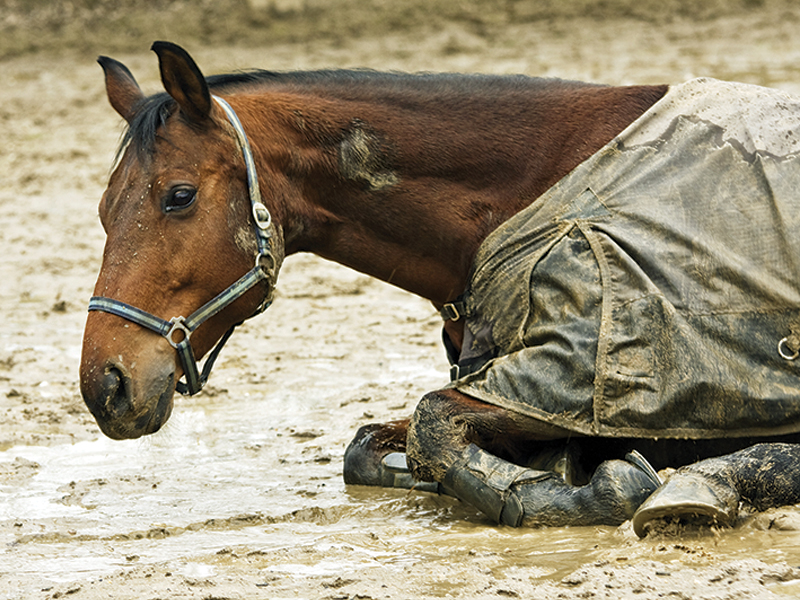
Property owners must be proactive about preparing for adverse weather conditions caused by climate change, and redesign properties to better manage horses in the face of more extreme weather events. Photo: Shutterstock/Sebastian Ueberwolf
These are just some of the ways to address ongoing weather changes that affect horses, properties, and their owners. But Wheaton’s best advice is to “be proactive in learning about climate change and its effects so that you’re not caught out.” Staying abreast of regional weather observations, climate change discussions related to your area, and horse health issues will help owners prepare for the future. By understanding what to expect and planning for ongoing weather changes, property owners can prevent expensive damage and repairs, while horse owners can ensure their horses remain happy and healthy.
Climate change is here and more change is on the way, so the best advice is: Be ready.
Related: Emergency Preparedness for Horses
References
Climate Action 2016 (2021). Mitigating the Detrimental Effects of Climate Change on Horse Health. Reviewed online.
Hristov A N ; Degaetano A T; Rotz C A; et al (2017). Climate Change Effects On Livestock in the Northeast US And Strategies For Adaptation. Climatic Change 146:33–45.
Natural Resource Canada (2021). National Issues Report. Ottawa, Ontario: Government of Canada. Reviewed online.
Rebbeck, Melissa A (nd). The Impact of Climate Change on Horses, and Horse Industries. Adelaide, South Australia: South Australian Research and Development Institute — Climate Applications.
Rojas-Downing, M Melissa; Nejadhashemi, A Pouyan; Harrigan, Timothy; Woznicki, Sean A (2017). Climate Change and Livestock: Impacts, Adaptation, and Mitigation. Climate Risk Management 16: 145-163.
Sauchyn, D., Davidson, D., and Johnston, M. (2020). Prairie Provinces: Chapter 4, Canada in a Changing Climate: Regional Perspectives Report. In F.J. Warren, N. Lulham and D.S. Lemmen (Eds). Ottawa, Ontario: Government of Canada.
Smith, Amanda (2020). The Land Management Guide for Horse Owners and Small-Lot Farmers. Langley, British Columbia: Langley Environmental Partners Society.
Related: Breathtaking: A Close Look at Equine Respiratory Diseases
Related: Henneke Equine Body Condition Scale
Main Photo: iStock/Steverts



